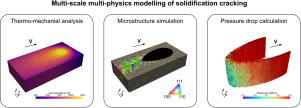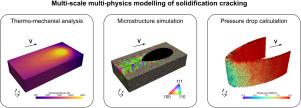A multi-scale modeling framework for solidification cracking during welding
IF 8.3
1区 材料科学
Q1 MATERIALS SCIENCE, MULTIDISCIPLINARY
引用次数: 0
Abstract
A multi-scale multi-physics modeling framework has been developed to predict solidification cracking susceptibility (SCS) during welding. The framework integrates a thermo-mechanical finite element model to simulate temperature and strain rate profiles during welding, a cellular automata model to simulate the solidified microstructure in the weld pool, and a granular model to calculate the pressure drop in the mushy zone. Verification was achieved by comparing the model’s predictions with welding experiments on two steels, demonstrating its capability to accurately capture the effects of process parameters, grain refinement, and alloy composition on SCS. Results indicate that increasing welding velocity, while maintaining a constant power-to-velocity ratio, extends the size of the mushy zone and increases the maximum pressure drop in the mushy zone, leading to higher SCS. Grain refinement decreases separation velocities and the permeability of liquid channels, which increases SCS, but it also raises the coalescence temperature, resulting in an overall reduction in SCS. Alloy composition impacts SCS through thermal diffusivity and segregation. Lower thermal diffusivity or stronger segregation tends to elongate the mushy zone, resulting in an increase in SCS. This framework provides a robust tool for understanding the mechanisms of solidification cracking, optimizing welding parameters to prevent its occurrence, and comparing SCS of different compositions during alloy design.


焊接过程中凝固裂纹的多尺度建模框架
为预测焊接过程中的凝固裂纹敏感性(SCS),开发了一种多尺度多物理模型框架。该框架集成了一个热机械有限元模型,用于模拟焊接过程中的温度和应变率曲线;一个单元自动机模型,用于模拟焊接熔池中的凝固微观结构;以及一个颗粒模型,用于计算粘稠区的压降。通过比较该模型的预测结果和两种钢材的焊接实验,验证了该模型能够准确捕捉工艺参数、晶粒细化和合金成分对 SCS 的影响。结果表明,在保持功率-速度比不变的情况下,提高焊接速度会扩大粘合区的大小,增加粘合区的最大压降,从而导致更高的 SCS。晶粒细化会降低分离速度和液体通道的渗透性,从而提高 SCS,但同时也会提高凝聚温度,导致 SCS 整体下降。合金成分通过热扩散和偏析影响 SCS。较低的热扩散率或较强的偏析往往会拉长粘稠区,从而导致 SCS 增加。这一框架为了解凝固裂纹的机理、优化焊接参数以防止其发生以及在合金设计过程中比较不同成分的 SCS 提供了强有力的工具。
本文章由计算机程序翻译,如有差异,请以英文原文为准。
求助全文
约1分钟内获得全文
求助全文
来源期刊

Acta Materialia
工程技术-材料科学:综合
CiteScore
16.10
自引率
8.50%
发文量
801
审稿时长
53 days
期刊介绍:
Acta Materialia serves as a platform for publishing full-length, original papers and commissioned overviews that contribute to a profound understanding of the correlation between the processing, structure, and properties of inorganic materials. The journal seeks papers with high impact potential or those that significantly propel the field forward. The scope includes the atomic and molecular arrangements, chemical and electronic structures, and microstructure of materials, focusing on their mechanical or functional behavior across all length scales, including nanostructures.
 求助内容:
求助内容: 应助结果提醒方式:
应助结果提醒方式:


